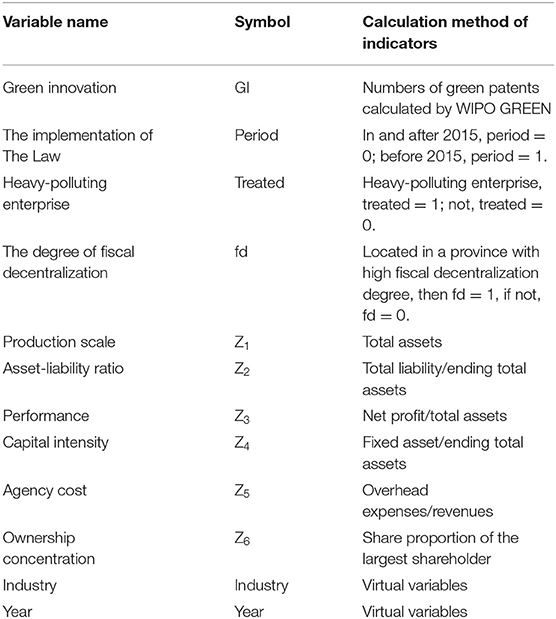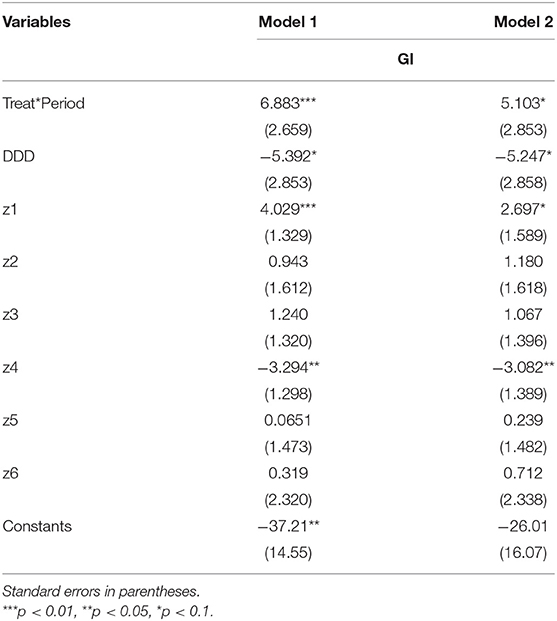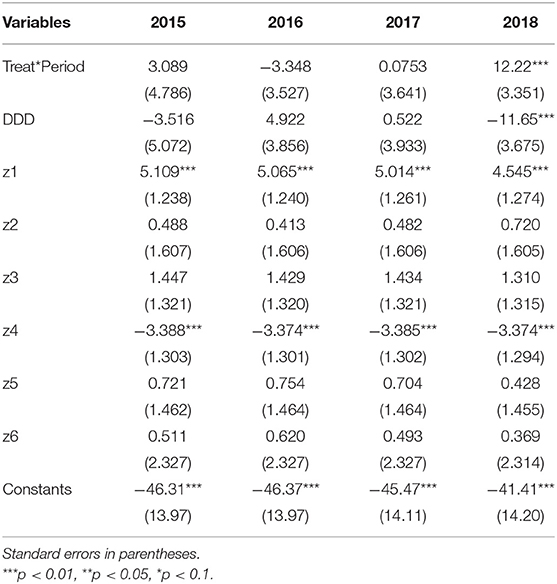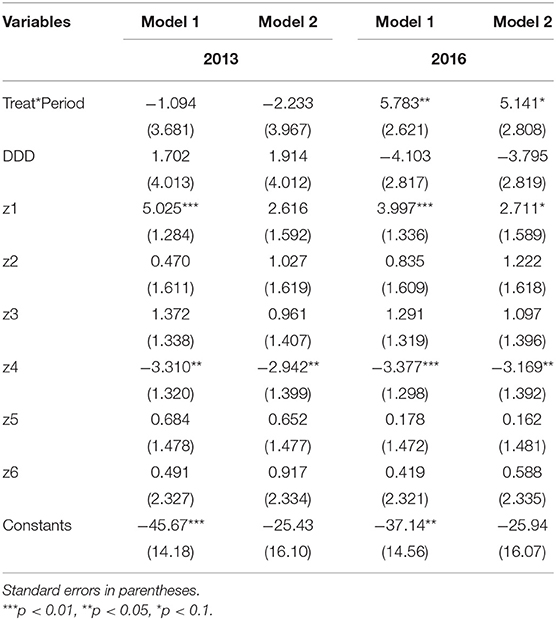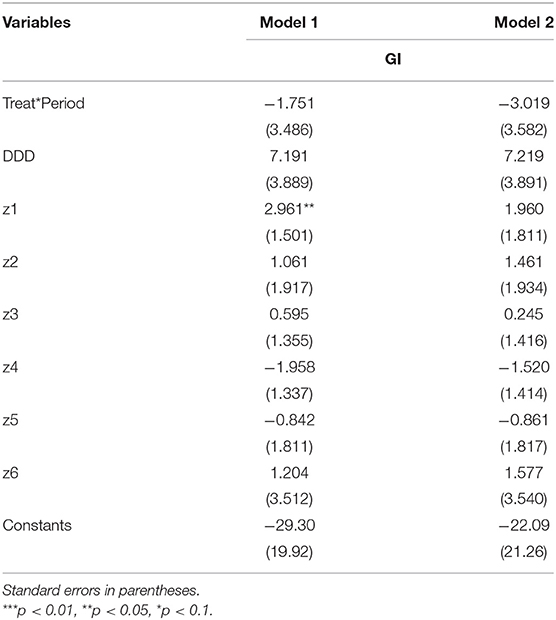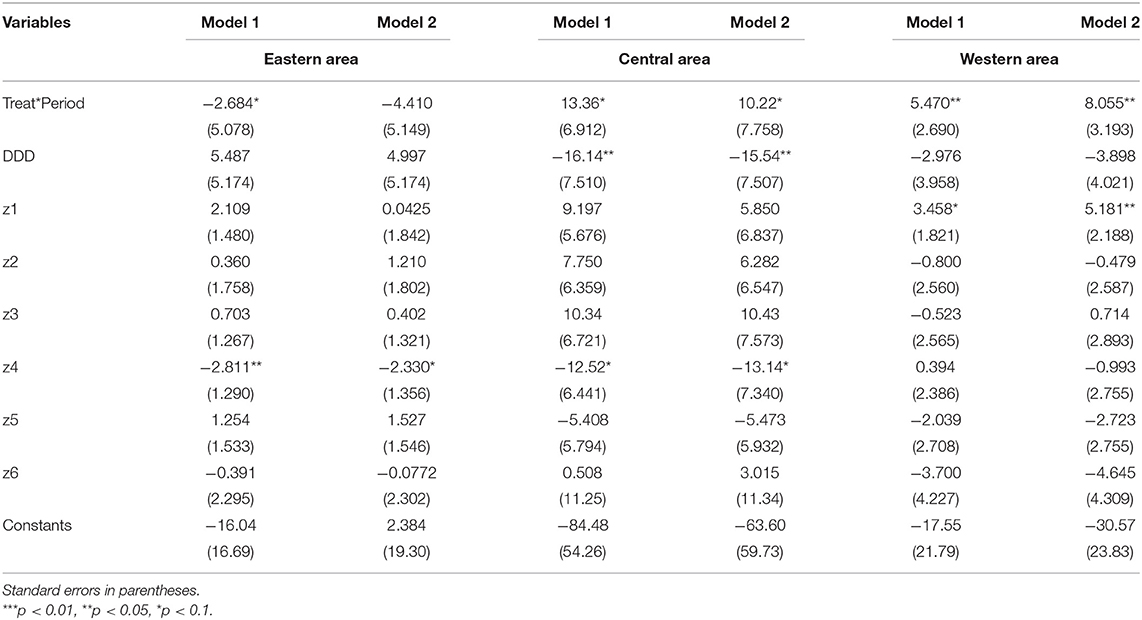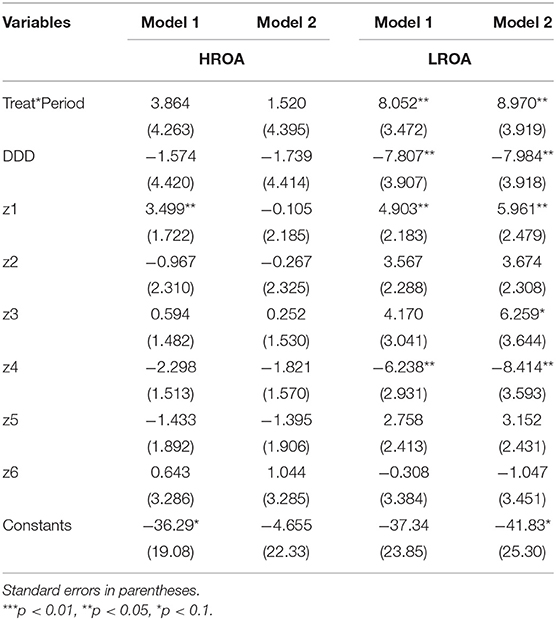- Business College, Central South University, Changsha, China
One of the main purposes of the 2015 Environmental Protection Law (EPL) of the People's Republic of China is to boost the green innovation of the enterprises. Using heavy-polluting enterprises as examples, this paper uses the Difference-in-difference analysis (DDD) technique to analyze the influence of EPL on the green innovation of enterprises under fiscal decentralization and enterprise heterogeneity. Results show that EPL exerts a negative impact on the green innovation of heavy-polluting enterprises at the national level, as well as those in the central and western areas specifically. The only presence of positive motivation for green innovation is being found in the eastern area, although, the motivation seems to be insignificant. The negative impacts have been lasting in the long run, especially for the low-performance enterprises in the central areas. As for the targeted implementation of EPL in China, local governments should make the best use of financial power under fiscal decentralization. This balanced approach is designed to motivate enterprises in different regions with various performance levels to develop green innovation based on their different weaknesses and strengths.
Introduction
Since its reform and opening up, rapid economic development has been experienced in China, but the task of conserving energy and reducing emissions has been unyielding. The Environmental Protection Law (EPL) of the People's Republic of China (Standing Committee of Twelfth National People's Congress of the People's Republic of China, 2015), January 1, 2015, was declared to establish and advocate coordination between economic development and environmental protection.
When compared to the former law, the number of articles in the EPL (SC-12th NPR, 2015) increased to 70, with larger environmental obligations and harsher punishments for polluting enterprises. These EPL articles delineated the environmental supervision responsibilities of local governments at all levels. Hence, it has become the most stringent environmental protection law in China. Heavy-polluting enterprises are the main targets of this restraint. The EPL (SC-12th NPR, 2015) clearly stipulates that pollutant-discharging enterprises and other operators shall take measures to prevent and control pollution and hazards such as waste gas, wastewater, waste residue, medical waste, dust, malodorous gas, and radioactive substances produced during production or other activities.
In the process of execution, the legal effect of the EPL (SC-12th NPR, 2015) can be realized through the regulation of two levels of government. It is determined by the fiscal decentralization system, which has an “economic decentralization and political centralization” characteristic. On one side, in the background of economic decentralization, the local governments have a certain decision-making power upon formulating local laws and regulations and implementing and supervising the behavior of enterprises; on the other side, in the background of political centralization, the central government evaluates the performance of the local officials, which has gradually added environmental indicators such as emissions cuts in recent years. In detail, the EPL (SC-12th NPR, 2015) clearly proposes that the State Council should set the national pollutant discharge standards and the local governments can set the relevant pollutant discharge standards at their discretion, but that they must be stricter than the national standards; pollutant discharging enterprises shall observe both the national total emission control system and regional key pollutant emission control system; if the polluters illegally discharge pollutants, they will be fined in accordance with the law. If they exceed the pollutant discharge standard or the total emission quota, the local government can order them to limit production, stop production for rectification, or suspend the business or close them down if the circumstances are serious; the central and local governments should take measures to promote the trial use of clean energy, encourage enterprises to choose processes and equipment that discharge less pollutants, and improve pollution-free treatment technologies; governments at all levels will increase financial input in environmental protection and implement the environmental protection target responsibility system for local governments; the central government shall supervise the implementation of local emission reduction and punish the competent environmental protection departments of governments that are unable to effectively enforce the law.
Due to the pressure of emission reduction, the application of scientific and technological innovation in the environmental protection industry is more extensive than before. Research on green innovation is strongly supported by the EPL (SC-12th NPR, 2015). It also mentioned that the adoption of policies and measures in finance, taxation, price, and government procurement, among others, would encourage and support the development of environmental protection industries such as technological equipment for environmental protection, comprehensive utilization of resources, and environmental services. Furthermore, in 2017, President Jinping's address to the 19th National Congress of the Communist Party of China, promoted both green innovation and green finance.
“We will create a market-based system for green innovation, develop green finance, and spur the development of energy-saving and environmental protection industries as well as clean production and clean energy industries (Xi, 2017).”
President Jinping also assured the Congress that the state shall support scientific and technological research, development, and application as a “holistic approach” to conserving our mountains, rivers, forests, farmlands, lakes, and grasslands; implement the strictest possible systems for environmental protection; and develop eco-friendly growth models and ways of life. The president Jinping also promised environmental protection, encouraged the development of environmental protection industries, promoted the development of information technology for environmental protection, and increased the scientific and technological level of environmental protection. Therefore, looking at regulating pollution through measures aimed at a green transformation, the EPL (SC-12th NPR, 2015) serves as an instrument for environmental regulation working through administrative orders that make following environmental policies mandatory. Simultaneously, it may motivate enterprises to pay more attention to the effect of green innovation in emission reduction.
Above all, the EPL (SC-12th NPR, 2015) is of highly theoretical and practical value in many aspects including defining green innovation requirements for enterprises, shaping fiscal decisions of local governments, and establishing and implementing environmental regulation policies. The major contributions of this paper are as follows. We discuss how the EPL (SC-12th NPR, 2015) influences the green innovation of enterprises under fiscal decentralization and focus to present on the heterogeneity of enterprises in green innovation from different areas based on the different problems and performance as well. The difference between this study and the existing literature focusing on the regulating effect or interaction effect is that this study conducted a quasi-experiment analysis based on fiscal decentralization and used EPL (SC-12th NPR, 2015) to examine the efficiency of environmental regulations.
The Progress of Environmental Remediation: A Literature Review
Facing all kinds of environmental regulations, the traditional neoclassical theory reckoned that the investment of enterprises in R&D (research and development) might be reduced to the high cost of environmental protection. Indeed, R&D investment was reduced, causing less innovation and poorer performance (Testa et al., 2011; Hottenrott and Rexh, 2015). Combined with microeconomic theory, Ziesemer (2013) indicated that environmental regulation was not always effective because enterprise innovation involved hidden interests beyond profit but environmental regulation did not. However, Porter (1991) praised the impact of environmental regulation on enterprise innovation from a dynamic aspect. For example, Lanjouw and Mody (1996) found that the number of patents on environmental remediation technology in the 1970s and 1980s increased based on higher environmental regulation through empirical data in America, Japan, and Germany. Nameroff et al. (2004) deemed that environmental regulation made by the government exerted considerable influence on the green innovation of polluting enterprises, because the external cost of competing in enterprise innovation was cut, thanks to the support from the government toward green products and services. Some scholars considered that the relationship between environmental regulation and enterprise innovation might switch between win-win and mutual restraint, as it might be affected by market conditions; game rules or strategies between regulated enterprises and the government; the environment or the life cycle of enterprise innovation; or the political system (Darnall et al., 2008).
Compared with ordinary technology innovation, the green innovation of enterprises based on the extension of innovation theory dates back to the 1990s. Amy Dietterich, the Director of the Global Challenge Division of the World Intellectual Property Organization (WIPO) defines green innovation as being dependent on technological innovation. In a WIPO Magazine article published on March 2020, she defined WIPO GREEN as an “online marketplace for sustainable technology,” which connects green innovators/providers with those seeking a green solution to a specific problem. This connection is achieved primarily through the WIPO GREEN database, which has more than 3,000 technologies, including prototypes and solutions that are on the market. Dietterich reported, “All featured technologies are available for license, collaboration, joint ventures and/or sale.” This service is also free for inventors/innovators if they simply list the benefits of their technology when they register online to join 1,500 internal users from 63 countries, including enterprises, universities, and research institutions (Dietterich, 2020). For Kemp and Pontoglio (2011), their concept of green innovation was called “eco-innovation,” which covered every aspect of environmental remediation technologies, including pollution through improved abatement technology, creating green products and cleaner and more efficient ways of processing them, green energy technology, and waste management. Song and Wang (2016) pointed out that enterprise innovation in technology with environmental protection features could boost its development through enhancing environmental quality. Furthermore, research into the causality of the effect of environmental regulation on green innovation was said to be on the rise. For instance, Calel and Dechezlepretre (2016) worked on the green innovation of enterprises from the perspective of environmental regulation in the environmental rights trading scheme.
Regional economy and innovation systems could not proceed without support from the government. In recent years, fiscal decentralization has become a fresh concept leading to discussion and research on its relationship to economic development and environmental issues, but no conclusion was established due to a wide range of different indicators, variables, sample sizes, time dimensions, area coverage, econometric models, and calculation methods in the empirical research. For example, Bernauer and Koubi (2013) thought that there are different degrees of public good concerned by governments, which set different fiscal expenditure for environmental benefits. Specifically, a government prioritizing people and the environment would focus on improving public services and the environment, while a money-seeking regime would be more likely to add to environmental deterioration. Halkos and Paizanos (2013) conducted research on the direct and indirect effects of fiscal decentralization on the environment and proved its long- and short-term impacts on environmental pollution. Fan and Zhang (2009) believed that resource allocation and efficiency could be optimized by delegating local financial power. This was a great opportunity for local governments to provide public services and relevant incentive policies in light of their own economic and environmental features, thereby creating an economic model that was suitable for indigenous resource distribution, which paved the way for the green innovation of enterprisers in products and technology. In this manner, talents and investment would pour into regions. Conversely, Zhang et al. (2017) and Zhao (2008) assumed that fiscal decentralization suppressed economic benefits, leading to competition distortions in local areas. Notably, economic development was crucial in the evaluation of officials, which means that problems including a race to the bottom of environmental regulation, unfair division of regional markets, overlapping economic projects, and shortsighted regional construction goals were always possibilities. These conditions were extremely unfavorable to the technology innovation of enterprises and the growth of totally green factor productivity.
Based on the existing literature, it is clear that most studies on environmental regulation and the green innovation of enterprises were from the perspective of industry or region at this stage, with little research considering enterprises as the subject at a micro level (the level of enterprises). As for the indicators of green innovation, they were always adjusted by multi-factor models in prior research because of their ambiguity. Researchers tend to consider various factors influencing green innovation, but in fact, the measurement of indicators such as the performance or the efficiency of green innovation might result in distorted understanding in empirical analysis. Thus, based on the WIPO GREEN classification, the number of green innovations in enterprises is measured as a specific indicator in this research. Heterogeneity is also a main factor, but when discussing the influence of environmental regulations on green innovation, some studies have ignored it. Given the effects of environmental regulations on entrepreneurial green innovation, the role of local fiscal decentralization has not attained an overall consensual evaluation, and the quasi-experimental treatment of fiscal decentralization as a political system perspective is relatively rare.
Effect of the Government On Green Innovation
The Importance of Government Regulation
In order to bring more public interests or legal private interests, the government would use macro regulation to directly intervene in the market mechanism or indirectly the decision-making of the enterprises. The Public Interest Theory postulates that if enterprises do not comply with some rules, the government should guide and regulate them in a way such that public interests are protected so as to guarantee the growth of social welfare. As a public good, environment has strong externalities and cannot gain benefits in the short run, it is not suitable for reasonable decisions made by enterprises or individuals. Lacking government regulation, the supply of public goods cannot be met by free markets, so it is a good theoretical reason for the government to make environmental regulations.
The Institutional Basis of Green Innovation Based on the Theory of Fiscal Decentralization
The theory of fiscal decentralization (or fiscal federalism) went through two generations in public economics. First-generation fiscal federalism (FGFF) emphasized that the government enjoyed advantages in offering public goods and services, and the government could also rectify some market failures by setting a policy. Second-generation fiscal federalism (SGFF) introduced mechanisms, incentive compatibility, and mechanism design. SGFF focused on the impact of institution and government officials' incentives on fiscal decentralization. Without certain restraints, local governments might prefer to pursue their own maximum interests rather than public welfare. Hence, a “market-preserving” decentralization result was produced. “Federalism with Chinese characteristics” was put forward by Chinese scholars, who deemed that the fiscal decentralization mode in China under the system of political centralization and economic decentralization was closer to meeting the conditions of market-preserving federalism in SGFF. The majority of established research in public economics discusses regional economic and technological development from the perspective of fiscal decentralization, but the green innovation of enterprises spotlights the regional heterogeneity of the environment; hence, the decision-making and financial power of a government should exert a more evident impact on boosting the green innovation of enterprises. Accordingly, there is a credible theoretical basis for determining the influence of different fiscal decentralization degrees in various regions on the green innovation of enterprises.
Hypothesis 1: Environmental Regulation Encourages Green Innovation
The Porter hypothesis argues that a properly designed environmental regulation policy can trigger green innovation in an enterprise that generates an innovation offset effect, and then reaches a “win-win” situation that allows enterprises to improve environmental and economic performance (Porter, 1991). Ronacchia and Lambertini (2021) divided the Porter hypothesis into a “strong” and a “weak” version. The weak version states that environmental regulation will effectively induce enterprise innovation, and the strong version states that environmental regulation will help enterprises step up economic performance. The latter could be a theoretical basis for this study on the influence of legal regulation on the green innovation of enterprises.
Therefore, based upon the government regulation theory, the theory of fiscal decentralization, and Porter hypothesis, the following hypothesis is suggested:
Hypothesis 1: Under fiscal decentralization, implementing the EPL (SC-12th NPR, 2015) has a significantly positive impact on the green innovation of enterprises.
Hypothesis 2: Heterogeneity on Green Innovation
The concept of a regional innovation system, a theoretical extension of the national innovation system, was introduced in the early 1990s. It originated from technological trajectories, which referred to continuity and localization of existing learning (knowledge) and innovation, as well as knowledge creation (educational) institutions. Cooke et al. (2000) proposed that a regional innovation system consists of a knowledge application and exploitation sub-system with enterprises in the relevant industry as major innovators, as well as a knowledge generation and diffusion sub-system with some public organizations promoting the diffusion of innovation. The region is a pivotal ground for economic regulation at a meso level; thus, regional innovation is generated from the cross effect of the networking of regional innovators, local clusters, and research institutions (Lundvall and Borras, 1997). Meanwhile, the values, attitudes, rules, customs, and expectations in a region taken together with the so-called regional culture intensify the interaction and innovation of enterprises in the region. This theory explains explicitly the regional clusters and growth of innovation in the domain of geographical economics.
Built on the theory of fiscal decentralization and regional innovation system, hypothesis 2 is proposed:
Hypothesis 2: Under fiscal decentralization, the implementation of the EPL (SC-12th NPR, 2015) shows great heterogeneity in its support of the green innovation of enterprises.
Methodology
Sample and Data Source
Based on examples of heavy-polluting A-share enterprises listed in the Shanghai and Shenzhen Stock Markets in 2012-2018 as samples, the authors deleted firms which were simultaneously listed in the AH/AB share, firms with ST or *ST designations, and newly listed firms when doing this research. According to the List of Classified Management of Environmental Protection Verification of Listed Companies (EIA Letter [2008] 373) issued by the Ministry of Environmental Protection in 2008, thermal power and 15 other industries were designated as heavy-polluting industries. After data screening, a list of 220 effective samples of indigenous innovation was finally set, with an effective data value of 5,280. Based on the Guidelines on Industry Classification of Listed Companies (Li and Zeng, 2020), the selections were classified as follows: B06 as the coal mining and processing industry; B07 as the oil and gas exploitation and production industry; B08 as the ferrous metal mining and dressing industry; B09 as the nonferrous metal mining and separating industry; C17 as the textile industry; C19 as the leather, fur, feather and their products, and footwear industry; C22 as the paper and paper products industry; C25 as the oil processing, coking, and nuclear fuel processing industry; C26 as the chemical industry; C27 as the pharmaceutical industry; C28 as the chemical fiber industry; C29 as the rubber and plastic products industry; C30 as the non-metallic mineral products industry; C31 as the non-metallic mineral products industry; C32 as the nonferrous metal smelting and rolling processing industry; C33 the metal products industry, and D44 the production and supply of electricity and heat industry.
In the 2012 Revised Guidelines on Industry Classification of Listed Companies China Securities Regulatory Commission [China Securities Regulatory Commission (CSRC), 2012], the categories of the selected industries were regarded as the treatment group in this article. Considering the homogeneity of the industry, other listed companies in the same category were counted as the control group, adopting the simple matching principle. Under the environmental regulations, heavy-polluting enterprises have a crucial part to play in mitigating environmental pollution in a direct or indirect way. Thus, it is of highly theoretical and practical significance to study the green innovation of enterprises. Financial, operational, and R&D data of the samples can be accessed from CNINFO, an official website for information disclosure of Chinese listed companies (cninfo.com.cn, 2020), including the annals of sample enterprises and patent data from enterprise annals and Patsnap. The data on green innovation (or green patent) could be collected and measured through matching IPC codes in the WIPO GREEN list and the IPC codes of every specific enterprise. All data were searched, screened, and collated manually.
Research Method
Green innovation and other forms of innovation are always affected by many factors like region, industry, market environment, and the political public environment, so a comparison analysis was made between the treatment and control groups based on changes in enterprise performance and innovation before and after enrolling in the EPL (SC-12th NPR, 2015). Besides, the authors were also looking for evidence of a significant impact of enterprise performance and innovation on fiscal decentralization. Difference-in-difference (DID) and Difference-in-difference (DDD) analyses were used under hypothetical circumstances in this study. If assumptions about parallel trends in DID failing, DDD, a method usually applied to research policy implementation; DDD is required to find another group of variables. Variables other than policy implementation were used to analyze the difference in an effort to reduce the errors in our results. The provinces in which the sample firms resided were considered as the second treatment and control groups according to their degree of fiscal decentralization. This was done to exclude the effect of industrial and fiscal decentralization on enterprise innovation and green innovation so as to obtain a more accurate analysis of the policy effect of the EPL (SC-12th NPR, 2015).
The general econometric model of DDD is given as follows:
where treatj is the treatment and control groups that decide whether to enact the policy; periodi is the year before and after implementing the policy; fdt is the second factor group which affects the explained variable apart from the policy itself; ε is the random disturbance term; treatjperiodifdt is the net effect of the policy and also the most important influence coefficient in DDD.
Specifically, in this paper, the values of the treatment group are marked to be 1 and those of the control group are marked to be 0; periods after the implementation of the policy are marked to be 1, and periods before the implementation of the policy are marked to be 0; enterprises with a high degree of fiscal decentralization are marked to be 1 and others are marked to be 0.
Variable Description
Explained variables: the green innovation of enterprise (GI). According to established research, the green innovation of enterprises could be indicated as the number of green patents (Ley et al., 2016; Van der Waal et al., 2021). Based on the WIPO GREEN list, firstly, the authors collected the IPC codes that were regarded as “green patent.” Secondly, the authors matched the IPC codes to ensure the number of green patents that specific enterprises possessed. Lastly, the number of green patents/innovation was acquired manually.
Explaining variables: the implementation period of the EPL (SC-12th NPR, 2015) (period); whether an enterprise is heavy polluting or not (treat); whether or not an enterprise has a high fiscal decentralization (fd). Specifically, before 2015, the value of the variable period is defined as 0, and after 2015, the value of the variable period is defined as 1; if the enterprise belongs to the category of heavy-polluting enterprises, then treat = 1, and if not, treat = 0; if the enterprise is located in a province with a high degree of fiscal decentralization, then fd = 1, if not, fd = 0. The calculation of the degree of fiscal decentralization is learned from the method of financial expenditure indicators proposed by Wu et al. (2020), i.e., the mean value of the ratio of the total provincial financial expenditures after deducting transfer payments to the central government as a budget expenditure and the ratio of the provincial financial expenditures excluding the transfer payments to the central government budget expenditure. The mean value of the fiscal decentralization indicators was adopted instead of the multiple-year panel data indicator as a way to avoid endogenous problems in the model caused by the regional fiscal decentralization indicators that change with the period. At the same time, all control variables were processed logarithmically in order to reduce heteroscedasticity.
Control variables: Relevant variables established from past works are selected: characteristic variables include R&D, the scale of the enterprise, capital intensity, agency cost, asset-liability ratio, and ownership concentration, as well as industry and annual variables. The description and calculation are shown in Table 1.
Model Settings
Based on the general model mentioned above and the model hypothesis in this study, the following model was built:
where GIijt are the explained variables, and Z is an umbrella term for all the control variables. The variation coefficient of green innovation is β4 + β7, among which the variation coefficient of the parallel trend assumption is β4. The variation coefficient of the net effect of DDD, which considers the degree of fiscal decentralization of the location of different enterprises, is β7. β7 is also the most important interaction term in this study, as it represents the influence effect of the EPL (SC-12th NPR, 2015) on the green innovation of enterprises after excluding the impact of industrial and fiscal decentralization.
Results and Discussion
Descriptive Analysis
In light of the above model settings, a descriptive analysis is shown in Table 2. The mean value of GI is 8.1766; the value of median is 3.4012; and the range is 273. These values suggest that enterprise innovation generated in the heavy-polluting industry is unstable, and the awareness and the ability of green innovation among enterprises tend to differ greatly. The mean value of the period is 0.5714, which manifests that the sample size before and after enacting the EPL (SC-12th NPR, 2015) is close, that is, samples in and after 2015 account for 57.14% of the total. This is enough to compare the data before and after carrying out the EPL (SC-12th NPR, 2015). The mean value of treat is 0.4955, meaning the sample size of the treatment group and the control group is balanced. The mean value of fd is 0.8364, indicating that samples with high fiscal decentralization degrees occupy a large part. It manifests that most enterprises prioritizing green innovation are located in regions with high degrees of fiscal decentralization. Basic statistics of other control variables are varied within a reasonable range. A negative value is a result of creating a logarithm in order to eliminate heteroscedasticity.
Correlation Analysis and Analysis of Parallel Trends
The correlation between the variables is reported in Table 3. The explained variables show certain correlations to all independent variables and control variables, and the degree of correlation between the independent variables and the control variables is 0.5 below, indicating a small possibility of multicollinearity. A panel regression analysis of DDD is necessary for identifying the specific functional relationship between the variables.
As for the parallel trend assumption, when it is admissible, the coherence of DID or DDD estimations can be assured. In detail, the relatively consistent period trends of treatment and control groups before implementing a show of policy that changes with time is not related to the changes in explained variables. On the contrary, the trends differ after policy enactment, fully manifesting the influence of the policy implementation quasi-experiment on the observed values of samples. Grounded in the DDD model set by this study, the parallel trends occur before enacting the EPL (SC-12th NPR, 2015), and inconsistencies clearly appear after the enactment of the EPL, which is significant under the variable values of heavy-polluting enterprises (the treatment group). As revealed by Figures 1, 2, the dividing point is the year 2015; the developing trends on the green innovation of enterprise between the treatment group and the control group tend to be parallel before 2015. Besides, there are significant differences in trends after 2015, with whatever degrees of fiscal decentralization. Thus, the green innovation of enterprises is verified with parallel trend assumption, and especially, a DDD regression analysis can be done.
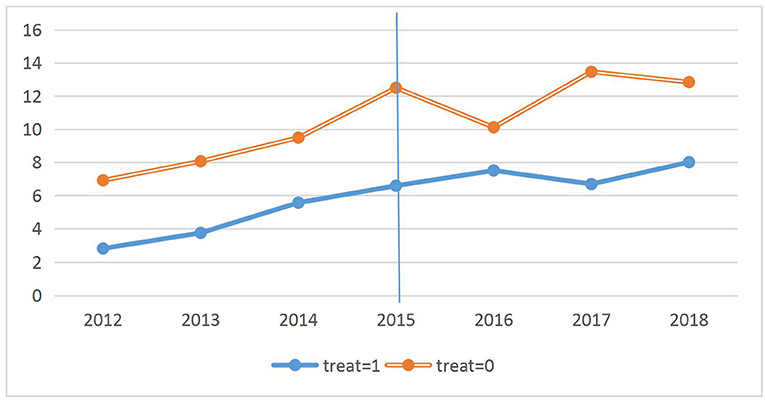
Figure 1. Parallel trends of green innovation of enterprises (regions with high degrees of fiscal decentralization).
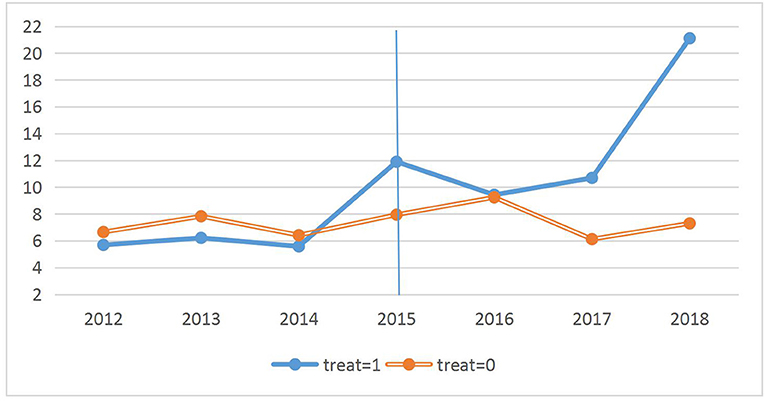
Figure 2. Parallel trends of green innovation of enterprises (regions with low degrees of fiscal decentralization).
DDD Regression Analysis
Before carrying out the DDD regression analysis, selecting a model is the priority. The fixed effects model can be identified after the Hausman test, in which the p-value of the three models is smaller than 0.05 (see Table 4). Table 5 reports the DDD regression results of the individual fixed effects model (Model 1) and the individual and time fixed effects model (Model 2) after adding control variables. It can be seen that the value of p, the interaction term of treat × period, is smaller than 0.01 in model 1 and smaller than 0.1 in model 2, which implies a refusal to the hypothesis. It represents that the parallel trends assumption under DID is invalid, i.e., further DDD regression is a necessity. The value of DDD is examined the hypothesis at 10% level under both models with the regression coefficient of −5.392 and −5.247, specifically. The results cannot support assumption one, because the impact of environmental regulation on green innovation is pessimistic. Consequently, the Potter hypothesis fails to be verified. Control variables exercise similar influence on two models, among which the production scale of the enterprise (z1) and the capital intensity (z4) affect the green innovation of enterprises significantly. A larger production scale or lower capital intensity will substantially increase the green innovation of an enterprise. All control variable results are stable under the individual fixed effects model and double fixed effects model.
Dynamic Effect Analysis
Based on the DDD analysis at the national level, a series of dynamic analyses delineating the effect of rolling out the EPL were conducted. In the further analysis, four new variables were added, DDD-treated*period*fd2015, treated*period*fd2016, treated*period*fd2017 and treated*period*fd2018, respectively; in order to investigate the specific dynamic effects in the four years after enacting EPL to accelerate the green innovation of enterprises. Specifically, taking the variable, treated*period2015, as an example, the virtual variable, 2015, is defined as 1, and the other years as 0. In Table 6, results from the individual fixed effects model are stated, including those of every year after the enactment of the EPL. The results show that the impacts of the control variables are similar to those in the DDD model at the national level (Table 5). Nevertheless, the impact of the enactment of the EPL on the green innovation of enterprises is significant in 2018, unlike in the years 2015–2017. This result may indicate that after enacting the EPL, the green innovation of enterprises has a significant impact but with a time-lag effect.
According to the results, authors presume that strict environmental regulation or punishment will enhance the enterprises' costs of environment, which may occupy the enterprises' costs of green innovation, so enterprises are likely to diminish green R&D inputs. Meanwhile, the compensatory effect from green innovation is not evident, so the Potter hypothesis cannot be verified at the national level.
Robustness Test
Placebo Test
The above analysis shows that under fiscal decentralization, the enactment of the EPL (SC-12th NPR, 2015) markedly promotes the green innovation of enterprises, but such promotion could also be a result of other factors. Therefore, the time of the policy implementation was tuned, based on the practice of Topalova (2010), and it was assumed that EPL was enacted in 2013 and 2016 in order to test the possibility of empirical results. Period, the virtual variable, was adjusted to 1 (based on a definition of conditions in and after 2013 as well as in and after 2016), and to be 0 in other years. Detailed information is reported in Table 7. Results reveal that the parallel trend assumption could not reject the null hypothesis, and the regression coefficients of the DDD are not significant in the individual fixed effects model and double fixed effects model (Model 1 and Model 2, respectively), so there were no other factors affecting the green innovation of enterprises. The conclusion of this study is robust.
The Adjustment of Samples
Although 220 heavy-polluting enterprises (109 of them were samples in the treatment group) were selected as samples, problems like an insufficient number of samples and deviations in the observed values may occur; therefore, the following method was used to test the efficiency of samples. The authors first randomly chose 109 enterprises and defined them as heavy-polluting enterprises, i.e., treated = 1 and others = 0. In this way, industrial heterogeneity could be tested. The details of the above test are in Table 8. The results show that no matter what is found in the individual fixed effects model or the individual and time fixed effects model, the regression coefficient of DDD is not significant after the industry definition is randomly changed, and the null hypothesis is not refused. Thus, the samples have passed the robustness test.
Regional Heterogeneity Analysis
Owing to the unbalanced Chinese regional economic development, factors affecting the green innovation of enterprises are going to be different. These factors include resource endowment, economic development, scale and intensity of R&D, environmental protection awareness, and degrees of policy enforcement. Therefore, the EPL regulations and the way they have been handled in different regions are worth discussing. Enterprise locations are classified into eastern, central, and western areas according to their registration address (in light of the regional divisions set up in the China Statistical Yearbook); the results are shown in Table 9. This information indicates that the green innovation of enterprises in all regions shows certain positive effects because of the EPL (SC-12th NPR, 2015). The regression coefficient of the green innovation of enterprises in the eastern area group is positive, but the influence is not significant. Unlike the DDD results at the national level, it is revealed that environmental regulation had a positive effect on the green innovation of enterprises. Unlike the results in the eastern area, the impacts of environmental regulation are negative in the other two areas, especially in the central area. The results found in the central and western areas are in accordance with the DDD results at the national level. Weak economic and R&D ability alongside extensive business models may be the source of the subtle damaging effect in the central and western enterprises. Some heavy-polluting enterprises have transferred to the central and western regions due to slacker policy enforcements despite environmental regulations. The environmental protection awareness of enterprises and the financial power of the government are not enough to make a difference in areas that are not under thorough public scrutiny.
In conclusion, the Potter hypothesis cannot be verified at the regional level, but the regional heterogeneity is significant. Thus, assumption 1 is not verified, and assumption 2 is true.
The Analysis of Enterprise Performance Heterogeneity
A huge amount of R&D is necessary for the green innovation of enterprises, but R&D capital, personnel, and stock will increase the cost and operational risk of enterprises. Therefore, heavy-polluting enterprises with different performances may differ after implementing the EPL (SC-12th NPR, 2015). To verify the hypothesis, samples with higher performances than the median are regarded as high-performance groups (HROAs), and those in the lower than median groups are designated as low-performance groups (LROAs). They are put into the DDD model. Clearly, Table 10 shows that the impacts of the enactment of the EPL on the green innovation of the enterprises are stronger in the low-performance groups than in the high-performance groups. The reason for this difference may include higher awareness of environmental protection and green innovation, advanced R&D technology, and stronger ability to cover increasing environmental costs in high-performance groups, so their green innovation projects and performances will be able to keep up, instead of incurring some kinds of voluntary production transformations or even terminations driven by environmental regulation. And of course, enterprises with low performance tend to be the other way round. Their operational cost and risk are on the up for indigenous innovation with lower competitiveness, so it would be harder for them to keep up with green innovation. Hence, the heterogeneity of enterprise performance is evident.
Conclusions and Discussion
Combined with the differences of regional fiscal decentralization with the enactment of the EPL as a starting point, DDD empirical research was conducted and validated on the green innovation of enterprises. The empirical results show that the EPL, as a kind of environmental regulation, makes a negative effect on the green innovation of enterprises at the national level. Specifically, the impact on green innovation is positive in the eastern areas, but it does not seem to be significant. On the other hand, the impacts in the central and western areas are negative, similar to those at the national level. Thus, the Potter hypothesis (assumption 1) cannot be verified. Furthermore, through comparisons of regions and levels of performance, the regional heterogeneity and the enterprise-performance heterogeneity are made evident. The results of heterogeneity analysis reveal that the significant effect of the EPL has shown the green innovation to be significantly prevalent in the eastern area and low-performance groups.
Based upon the above conclusions, the following suggestions are what the authors put forward:
(1) Under a political-institutional background, fiscal decentralization delegates power to local governments to develop local green innovation. Meanwhile, the central government shall make strategic goals and motivate the green innovation of enterprises through the evaluation systems of the local officials. This could facilitate and deepen corresponding supports from local governments.
(2) Local governments shall make good use of financial power under fiscal decentralization to supply policy supports toward the green innovation of enterprises; for example, highlighting the R&D of infrastructure in an effort to attract R&D talents from home and abroad, providing larger R&D input and more platforms for exchange, implementing preferential tax policy for green innovation, and improving the market value of green innovation may be beneficial.
(3) Based on the regional heterogeneity, local governments shall implement and adjust the EPL (SC-12th NPR, 2015) properly according to local conditions. Especially, the positive impact on the green innovation of enterprises in the eastern area is worth analyzing and learning. To transform the impacts on green innovation from negative to positive, enterprises in the central and western areas shall find out or reinforce their own priorities on green innovation and competitiveness.
(4) The green R&D awareness of enterprises shall be raised so that they can reform and adjust the environmental innovation system actively until their business models become an example of best practices for establishing clean production and sustainability.
Data Availability Statement
The original contributions presented in the study are included in the article/supplementary material, further inquiries can be directed to the corresponding author/s.
Author Contributions
All authors listed have made a substantial, direct and intellectual contribution to the work, and approved it for publication.
Funding
This work was supported by the National Natural Science Foundation of China, The Dynamic Mechanism and Policy Optimization of Green Technology Innovation Diffusion Based on the Theoretical and Empirical Analysis from the Perspective of Co-opetition (Grant No. 71974209), from January 2020 to December 2023.
Conflict of Interest
The authors declare that the research was conducted in the absence of any commercial or financial relationships that could be construed as a potential conflict of interest.
Acknowledgments
The authors thank AiMi Academic Services (www.aimieditor.com) for English language editing and review services.
References
Bernauer, T., and Koubi, V. (2013). Are bigger governments better providers of public goods? Evidence from air pollution. Public Choice 156, 593–609. doi: 10.1007/s11127-012-9916-1
Calel, R., and Dechezlepretre, A. (2016). Environmental policy and directed technological change: evidence from the European Carbon Market. Rev. Econ. Stat. 98, 173–191. doi: 10.1162/REST_a_00470
China Securities Regulatory Commission (CSRC) (2012). Guidelines for the Industry Classification of Listed Companies (2012 Revision). Available online at: http://www.csrc.gov.cn/pub/csrc_en/newsfacts/release/200708/t20070816_69104.html
cninfo.com.cn (2020). July 2020 Overview, an online information source on Chinese companies. Available online at: https://www.similarweb.com/website/cninfo.com.cn/
Cooke, P., Boekholt, P., and Todtling, F. (2000). The Governance of Innovation in Europe[M]. Regional Perspectives on Global Competitiveness. London: Pinter.
Darnall, N., Henriques, I., and Sadorsky, P. (2008). Do environmental management systems improve business performance in an international setting? J. Int. Manage. 14, 364–376. doi: 10.1016/j.intman.2007.09.006
Dietterich, A. (2020). WIPO GREEN: Supporting green innovation and technology transfer. WIPO MAGAZINE, March 2020, a quarterly online and print publication. Available online at: https://www.wipo.int/wipo_magazine/en/2020/01/article_0003.html
Fan, Z. Y., and Zhang, J. (2009). Between China's fiscal decentralization and the efficiency of China's Economic Growth. Management World 7, 15–25. doi: 10.19744/j.cnki.11-1235/f.2009.07.003
Halkos, G. E., and Paizanos, E. A. (2013). The effect of government expenditure on the environment: an empirical investigation. Ecol. Econ. 91, 48–56. doi: 10.1016/j.ecolecon.2013.04.002
Hottenrott, H., and Rexh, S. (2015). Policy-induced environmental technology and inventive efforts: is there a crowding out? Industry Innovation 22, 375–401. doi: 10.1080/13662716.2015.1064255
Kemp, R., and Pontoglio, S. (2011). The innovation effects of environmental policy instruments: a typical case of the blind men and the elephant. Ecol. Econ. 72, 28–36. doi: 10.1016/j.ecolecon.2011.09.014
Lanjouw, J. O., and Mody, A. (1996). Innovation and the international diffusion of environmentally responsive technology. Res. Policy 25, 549–571. doi: 10.1016/0048-7333(95)00853-5
Ley, M., Stucki, T., and Woerter, M. (2016). The impact of energy prices on green innovation. Energy J. 37, 41–75. doi: 10.5547/01956574.37.1.mley
Li, D., and Zeng, T. (2020). Are China's intensive pollution industries greening? An analysis based on green innovation efficiency. J. Clean. Prod. 259:120901. doi: 10.1016/j.jclepro.2020.120901
Lundvall, B. A., and Borras, S. (1997). The Globalising Learning Economy: Implications for Innovation Policy Report based on contributions from seven projects under the TSER programme DG XII, Commision of the European Union. Available online at: http://www.globelicsacademy.org/2011_pdf/Lundvall%20Borras%201997.pdf
Nameroff, T. J., Garant, R. J., and Albert, M. B. (2004). Adoption of green chemistry: An analysis based on US Patents. Res. Policy 33, 959–974. doi: 10.1016/j.respol.2004.03.001
Porter, M. (1991). America's green strategy[M]. Sci. Am. 264:168. doi: 10.1038/scientificamerican0491-168
Ronacchia, C., and Lambertini, L. (2021). Porter hypothesis vs pollution haven hypothesis: can there be environmental policies getting two eggs in one basket? Environ. Res. 78, 177–199. doi: 10.1007/s10640-020-00533-x
Song, M., and Wang, S. (2016). Can employment structure promote environment-biased technical progress? Technol. Forecasting Soc. Change 112, 285–292. doi: 10.1016/j.techfore.2016.02.016
Standing Committee of Twelfth National People's Congress of the People's Republic of China (2015). Environmental Protection Law of People's Republic of China. Standing Committee of Twelfth National People's Congress of the People's Republic of China.
Testa, F., Iraldo, F., and Frey, M. (2011). The effect of environmental regulation on firm's competitive performance: The case of the building & construction sector in some EU regions. J. Environ. Manage. 92, 2136–2144. doi: 10.1016/j.jenvman.2011.03.039
Topalova, P. (2010). Factor immobility and regional impact of trade liberalization: evidence on poverty from India. Am. Econ. J. 2, 1–41. doi: 10.1257/app.2.4.1
Van der Waal, J. W. H., Thijssens, T., and Maas, K. (2021). The innovative contribution of multinational enterprises to the sustainable goals. J. Clean. Prod. 285:125319. doi: 10.1016/j.jclepro.2020.125319
Wu, H., Li, Y., Hao, Y., Ren, S., and Zhang, P. (2020). Environmental decentralization, local government competition, and regional green development: evidence from China. Sci. Total Environ. 708:135085. doi: 10.1016/j.scitotenv.2019.135085
Xi, J. (2017). Full text of Xi Jinping's report at 19th CPC National Congress, ChinaDaily.com delivered by President Jinping. Available online at: https://www.chinadaily.com.cn/china/19thcpcnationalcongress/2017-11/04/content_3 4115212.htm (accessed October 18, 2017).
Zhang, K., Zhang, Z. Y., and Liang, Q. M. (2017). An empirical analysis of the green paradox in China: from the perspective of fiscal decentralization. Energy Policy 103, 203–211. doi: 10.1016/j.enpol.2017.01.023
Zhao, W. (2008). A study on the relationship between fiscal decentralization, frontier technical development and technical development and technical efficiency. Management World 33–44,187. doi: 10.19744/j.cnki.11-1235/f.2008.07.005
Keywords: green innovation, environmental protection law, fiscal decentralization, DDD analysis, environmental regulation
Citation: Ouyang L and You D (2021) The Green Innovation Effect on Heavy-Polluting Enterprises Under the Environmental Protection Law. Front. Energy Res. 9:681334. doi: 10.3389/fenrg.2021.681334
Received: 16 March 2021; Accepted: 09 April 2021;
Published: 11 May 2021.
Edited by:
Kangyin Dong, University of International Business and Economics, ChinaReviewed by:
Ma Yongjun, Hunan University of Technology, ChinaSihuan Li, Huaihua University, China
Xiaohui Shu, Huaihua University, China
Copyright © 2021 Ouyang and You. This is an open-access article distributed under the terms of the Creative Commons Attribution License (CC BY). The use, distribution or reproduction in other forums is permitted, provided the original author(s) and the copyright owner(s) are credited and that the original publication in this journal is cited, in accordance with accepted academic practice. No use, distribution or reproduction is permitted which does not comply with these terms.
*Correspondence: Leqian Ouyang, NTYzMzMxOTAyQHFxLmNvbQ==
 Leqian Ouyang
Leqian Ouyang Daming You
Daming You